Juicy fruit falling from trees like mana from heaven. Mulberries are a taste of days gone by, and an exciting fruit that can be foraged in large quantities. You won't need to chase monkeys and weasels to get them, but you might need to climb a tree. Today I'll share everything I've learned about foraging and cooking this fascinating and confusing wild fruit.

Despite the children's rhyme, these are a tree, not a bush, and there's a number of varieties in the family Moraceae. The common mulberry tree for most people, and the focus of this post, is the Asian white mulberry or silk mulberry (Morus alba, formerly Morus multicaulis).
White mulberry trees were brought to the United States in the 1900's in hopes of creating a mulberry silk industry. as the leaves are apparently a good food for silk worms. Beyond silk and fruit, the deciduous trees are a hardwood that's supposed to make excellent firewood.

Besides the Asian variety there's Morus rubra, the red mulberry native to North America, which is rare in the Midwest. The black mulberry (Morus nigra) been cultivated for hundreds of years in Europe, and much longer in China and Asia where it's native. Then there's the Pakistani mulberry (Morus macroura) that produces the largest fruit at around 4 inches long.
How to Identify a Mulberry Tree
There's a number of confusing aspects to understand: the leaves, the color of the fruit, and the genetic mess caused by the Asian variety hybridizing with the native species.
Leaves
Mulberry leaves vary in shape and can be oval-shaped or lobed. Lobed leaves are more common on young saplings.
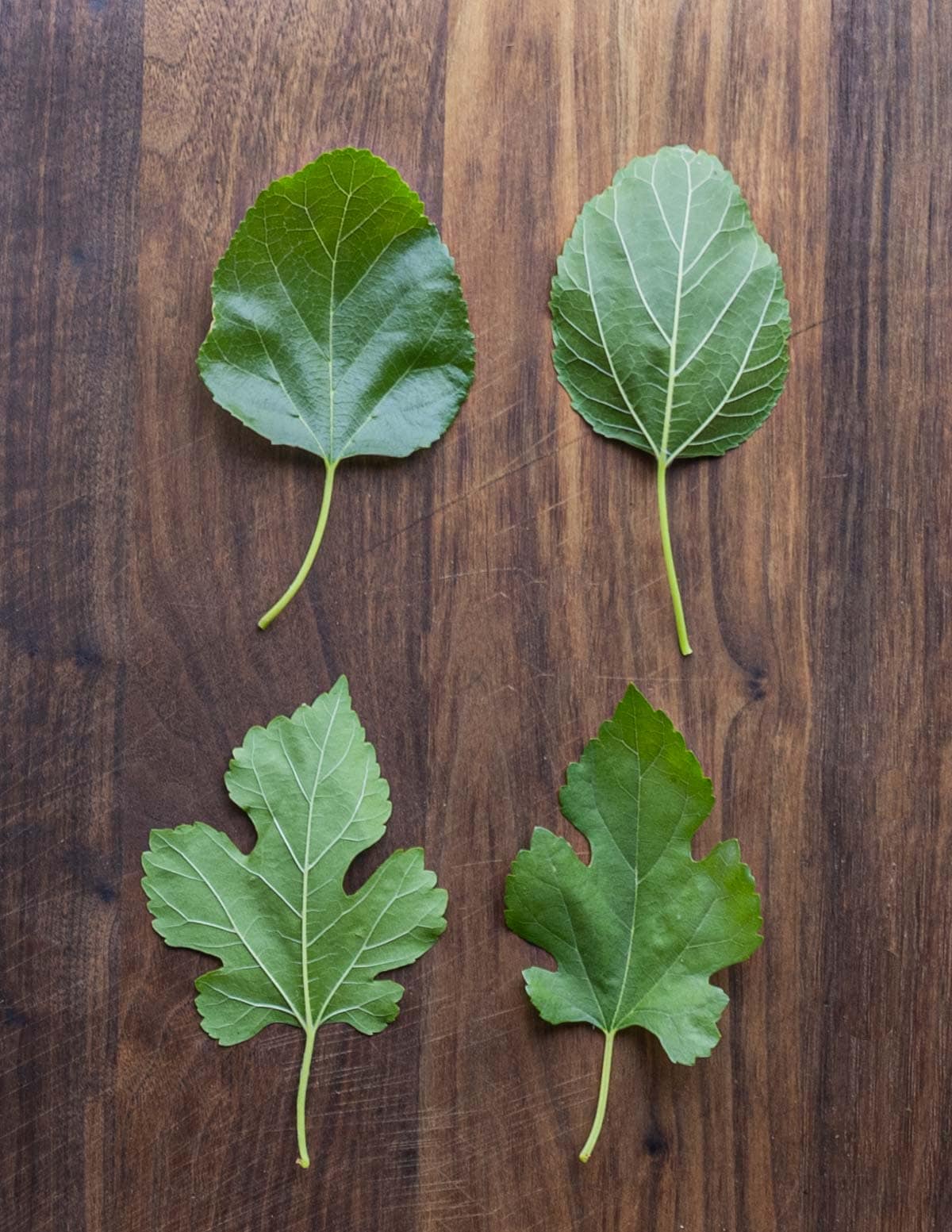
The bark of mature trees has tell-tale yellow fissures with numerous gray ridges.
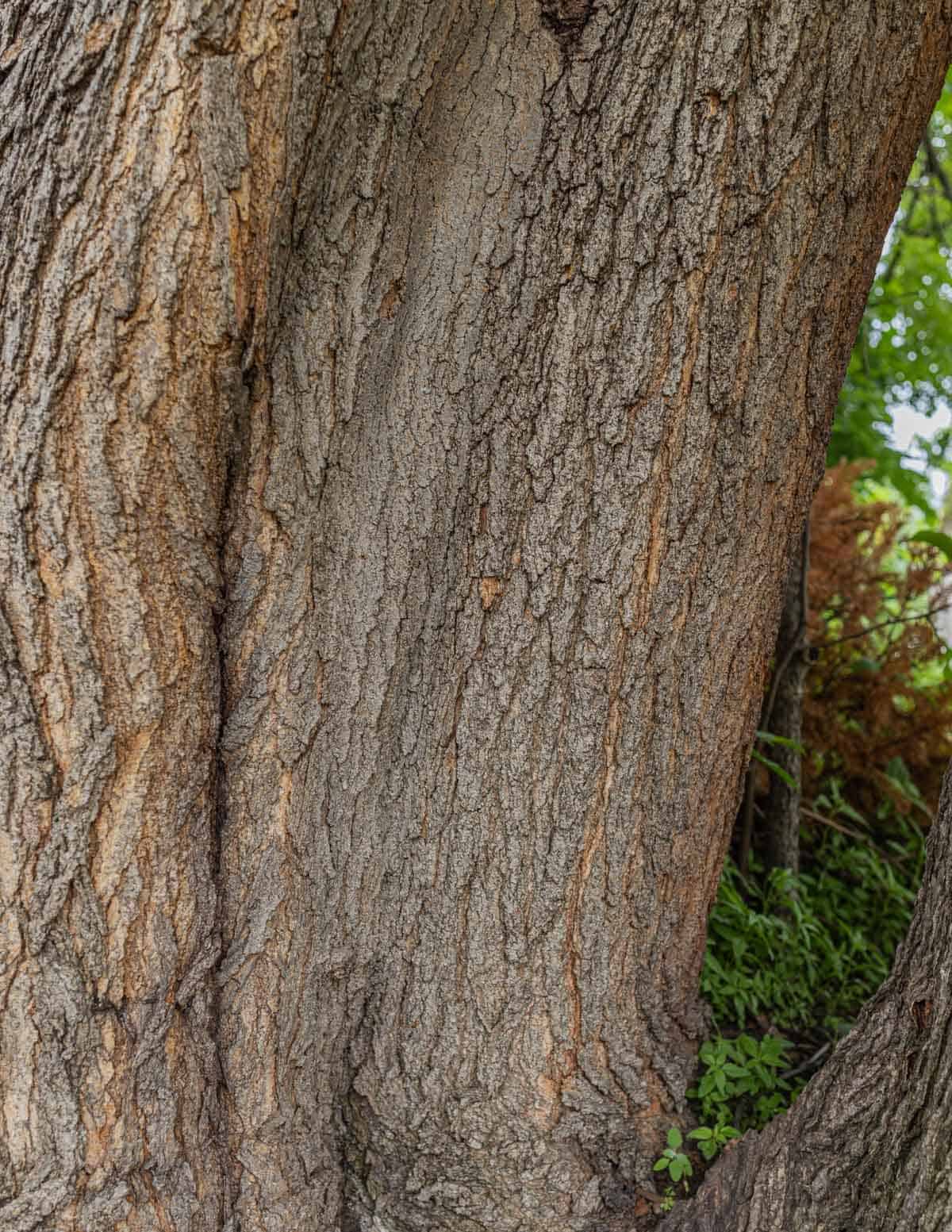
Mulberries growing in yards and urban areas are often confused for weeds. The fast growing young saplings have a slightly messy, disorganized look to them.


Mulberry Fruit
The most confusing part of the white mulberry is that the ripe fruit can be white or purple-ish black when ripe depending on the individual tree. The name alba means white and is ill-conceived, as trees producing white fruit are essentially an albino variation less common than the darker, purple fruit.
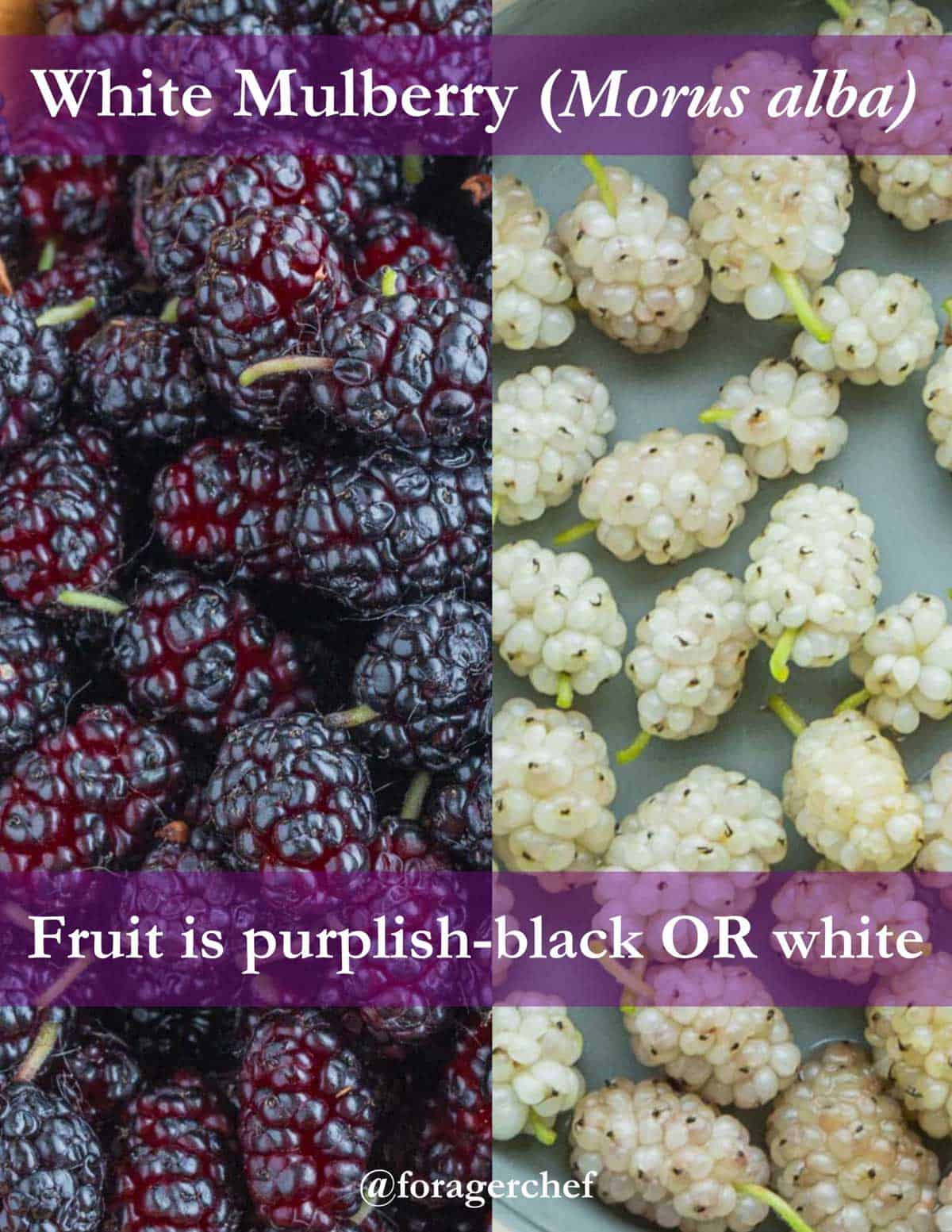
This is one of the most misunderstood aspects of the tree. Nurseries and garden centers are well known for selling "black mulberry trees" that are actually Morus. alba.
Hybrids
Asian mulberry cross-pollinates and hybridizes with native Morus rubra. Over the roughly 200 years they've been in North America they've slowly diluted the genetics of our native species.
Separating hybrids from the native variety is difficult, often confusing skilled foragers even in areas where red mulberries are more common. There's also fruitless/sterile ornamental varieties planted to prevent purple stains on sidewalks.

The person most skilled in identifying true M. rubra from hybrids I know is Samuel Thayer. Sam's currently growing our native spcies, pictured below, and, in time, will hopefully have seedlings to share in the hopes of protecting and preserving this special American tree.

Are Mulberries Poisonous?
If identification wasn't confusing enough, there's a handful of warnings of unripe mulberries being poisonous or hallucinogenic. Foraging author Tom Brown's account is probably the most repeated example I see referenced.
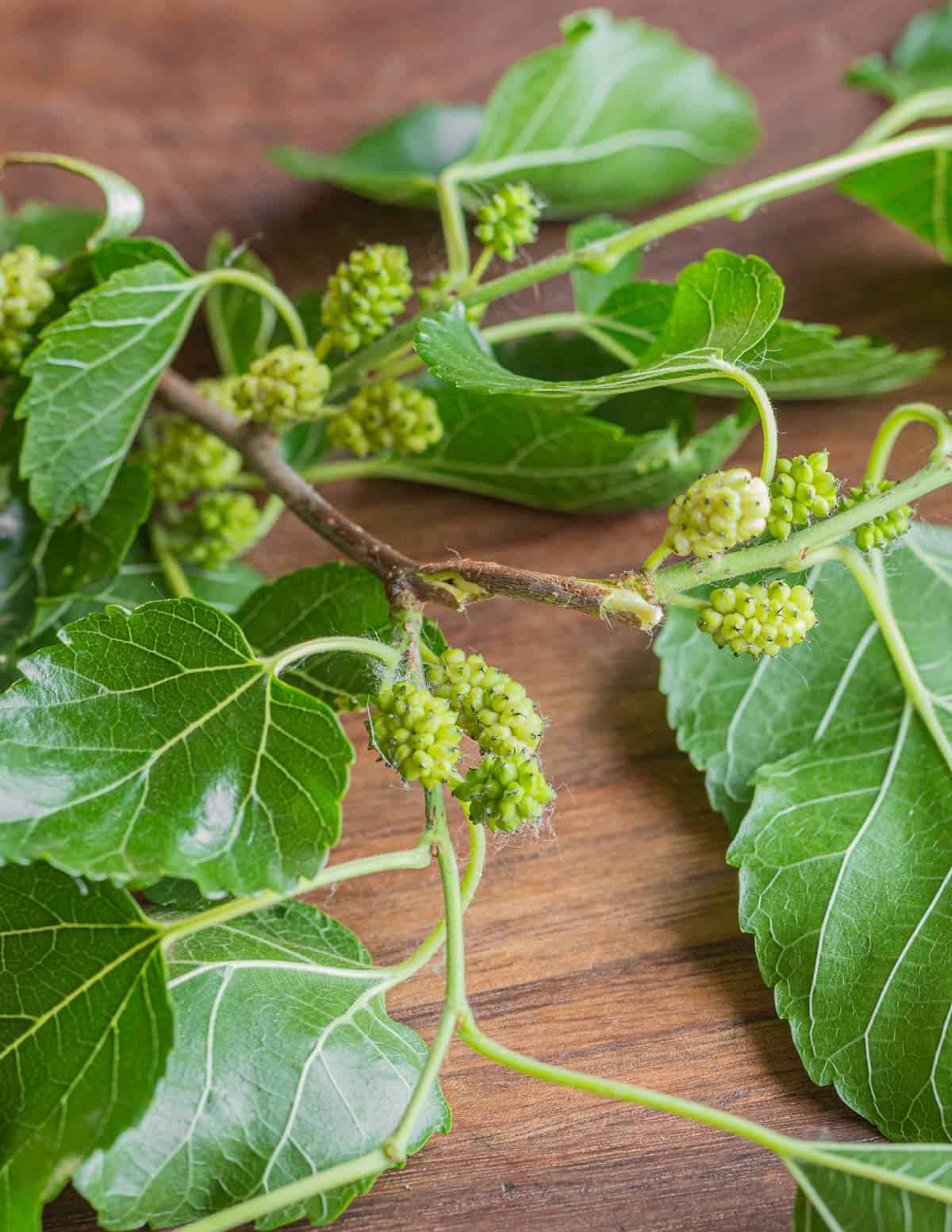
All varieties of mulberry are edible and I don't consider them poisonous. While it's fine to eat a few unripe fruit I won't be eating them by the handful.

I don't eat unripe mulberries simply because the unripe fruit is dry and tasteless. That said, there's a few things I think are important to consider here.
- Accounts of narcotic effects I've read refer to eating raw, unripe fruit and not cooked, ripe fruit.
- I may eat around 10 pounds of cooked fruit a year and I've never felt anything out of the ordinary, even after large servings.
- Other anecdotal accounts of mulberry poisoning are often referring to potent extracts of white mulberry leaf.
While the plant may have some medicinal aspects when taken in a medicinal dose, especially raw. In my mind they're harmless, and I agree with Sam Thayer that any danger associated with this fruit is likely over-exaggerated. This tree has been used as a food for a very long time.
When to Harvest Mulberries
Mulberry season in the Upper Midwest is typically Early July and a month or two earlier the farther south you go. Ripe fruit are pure white or purplish-black when ripe, although a little red is ok and common in ripe fruit.

Before you harvest, taste some of the fruit. Ripe mulberries should taste like a combination of raisin and fig with a touch of molasses, but tastes can vary drastically from tree to tree, and some can be near-flavorless.
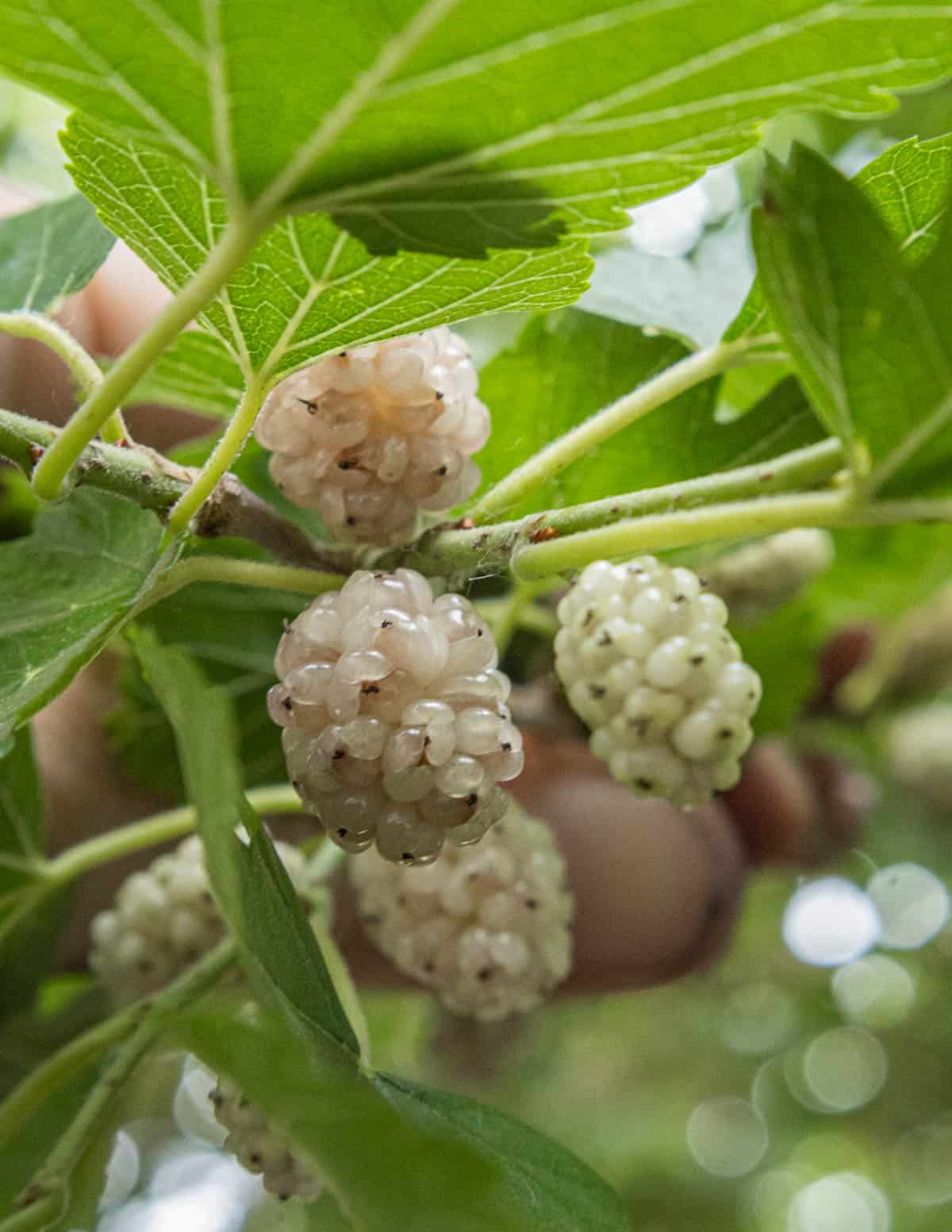
There's a few different ways to harvest the fruit depending on how much you want. Each method has different pro's and cons to consider.
Harvesting by Hand
Picking the fruit by hand will produce the highest quality fruit with the longest shelf life. It's also the most labor intensive.

Shaking the Tree
Shaking trees to collect the fruit is a method used around the world where the fruit is traditionally eaten. Seeing 5 or ten pounds of food fall from a tree en-masse is an awe-inspiring experience and a foraging skill worth taking the time to learn.
To harvest by shaking the tree, get a friend or group of friends and lay impeccably clean tarps on the ground to cover where the berries will fall. Climb the tree and gently shake the branches to make the ripe fruit fall to the ground. Special thanks to my friend Peter Erik who helped me with the tree shaking for this post.


Another good way to harvest is to throw a rope over low-hanging branches to shake them. It's a good compromise if you're not very skilled at climbing trees like me.

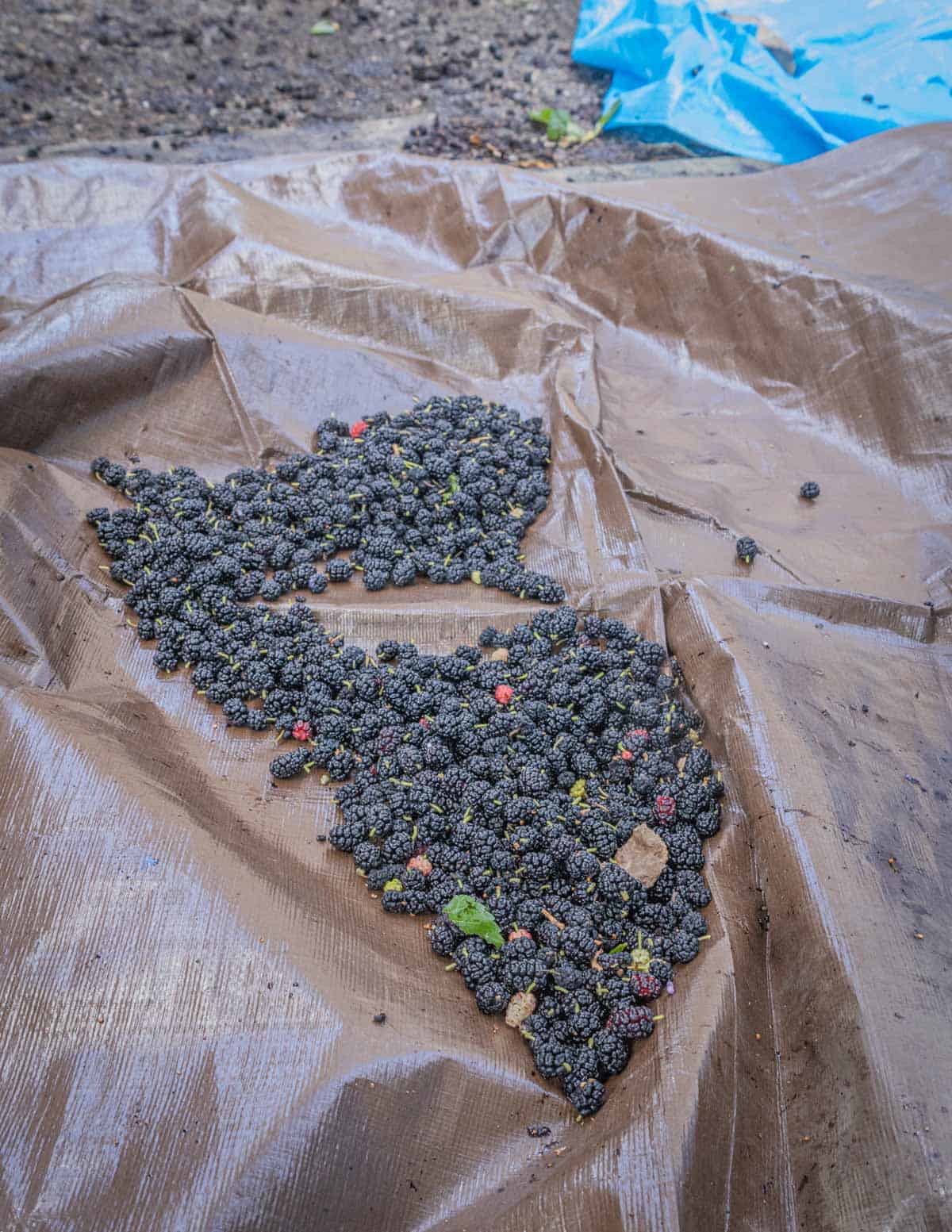
Shaking trees to collect fruit produces the largest harvest, but has its own caveats. Here's some important things to know:
- The bigger the tree, the more fruit it produces.
- In urban areas you'll get fewer stares and inquires about your housing situation if a friend's with you.
- You can throw a rope over low hanging branches instead of climbing.
- Climbing trees can be dangerous. wear tight-fitting shoes and have a friend with you.
- Shaken fruit has a shorter shelf life and needs to be picked clean of debris.
- Chill your fruit as soon as possible to prevent fermentation or mold.
- Mulberries are susceptible to invasive fruit fly larvae that look like tiny white maggots. I think it's the Spotted-Wing Drosophila.
- The fruit ripens unevenly. Make repeated trips to your trees to get the most fruit.
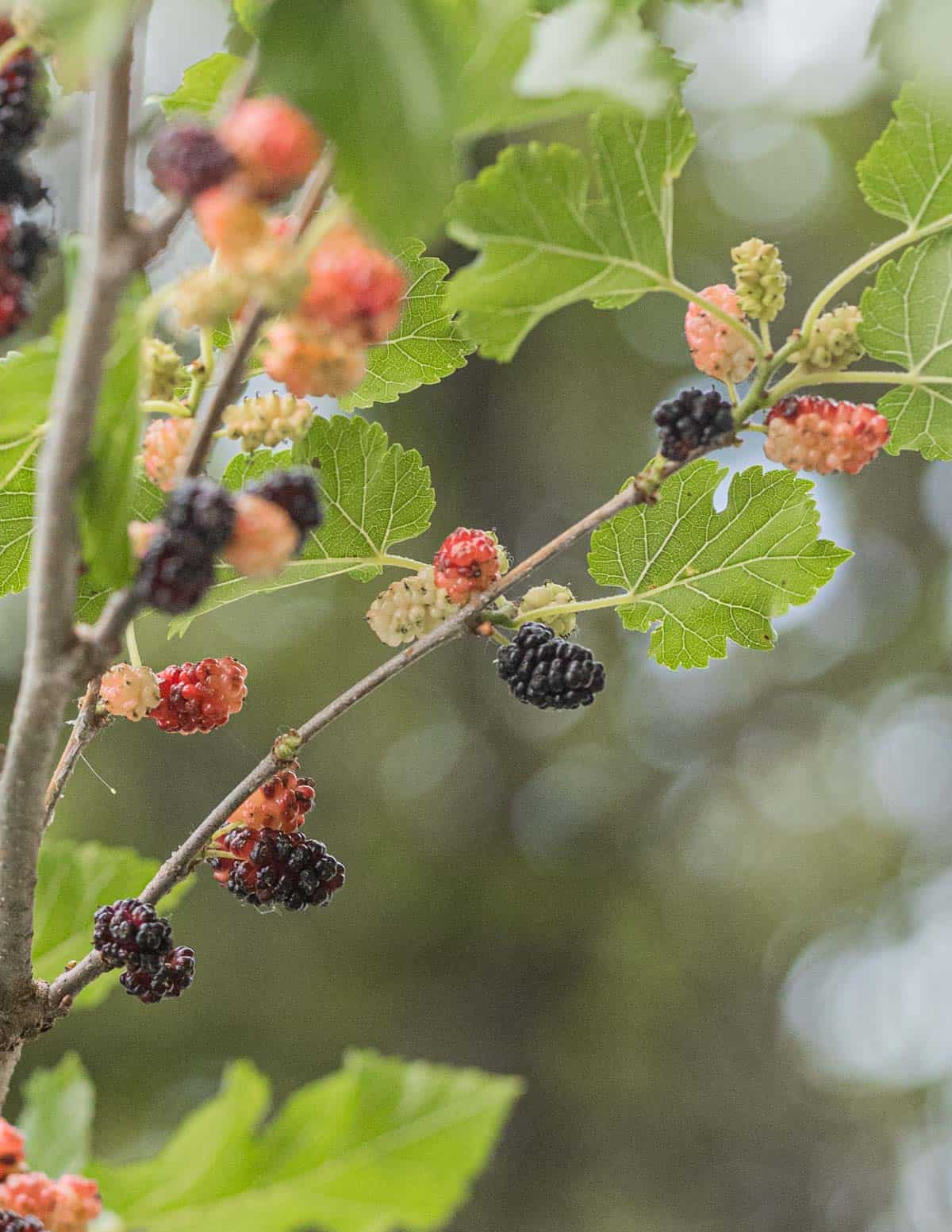
How to Clean Mulberries
Ripe fruit picked by hand will be clean and can be treated like any other fresh berry. Fruit shaken from a tree will need to be cleaned.
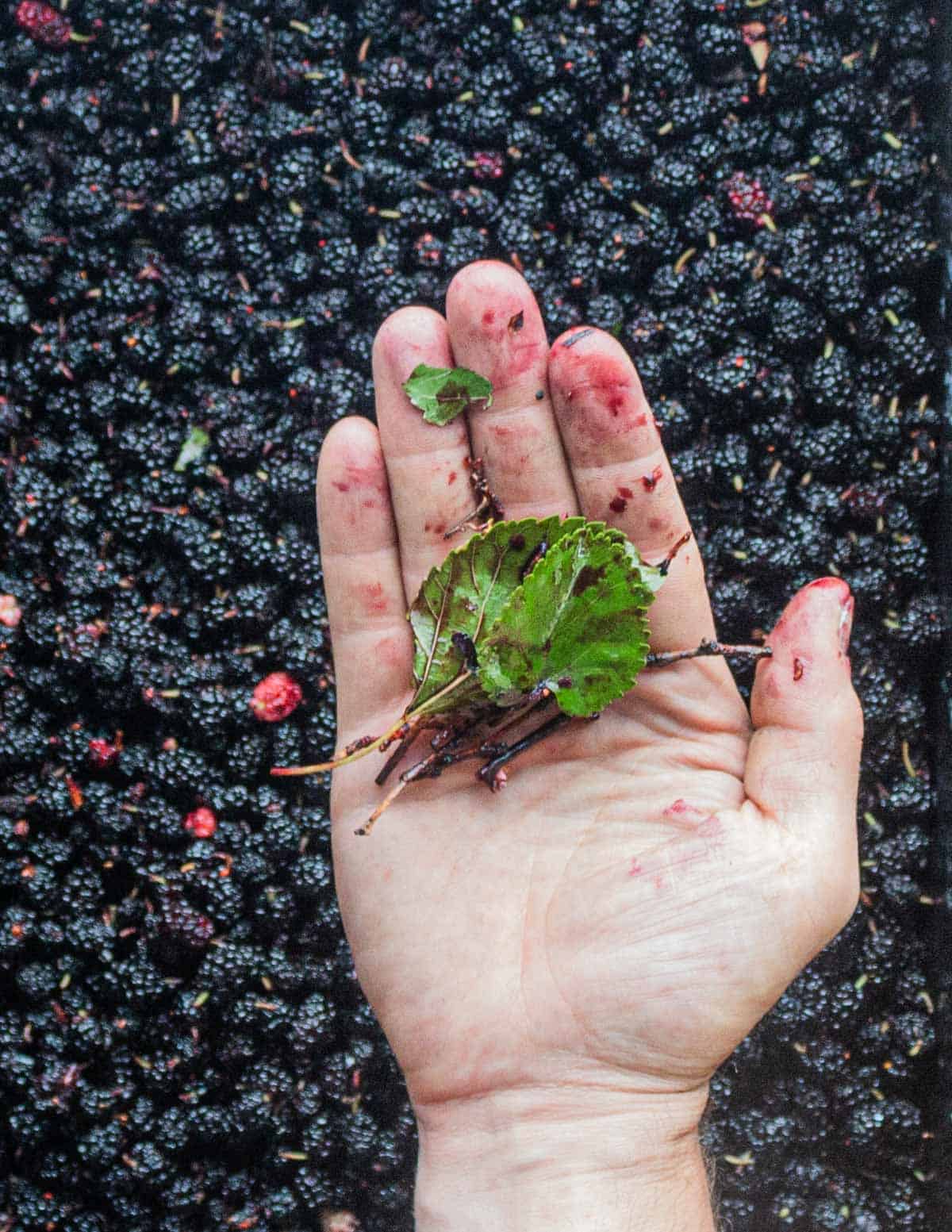
The most effective way to clean the fruit I've found is simply laying the berries in a single layer on a baking sheet and picking them over by hand for leaves, twigs and debris.
You may be tempted to wash mulberries that are dirty. Some soak mulberries in water to remove bugs and insects, but this robs them of juices and can result in watery, flavorless fruit, especially if they've been bruised. I prefer to use dirty fruit to make mulberry vinegar or liqueurs that will be strained, like cassis, although jam is an option too.
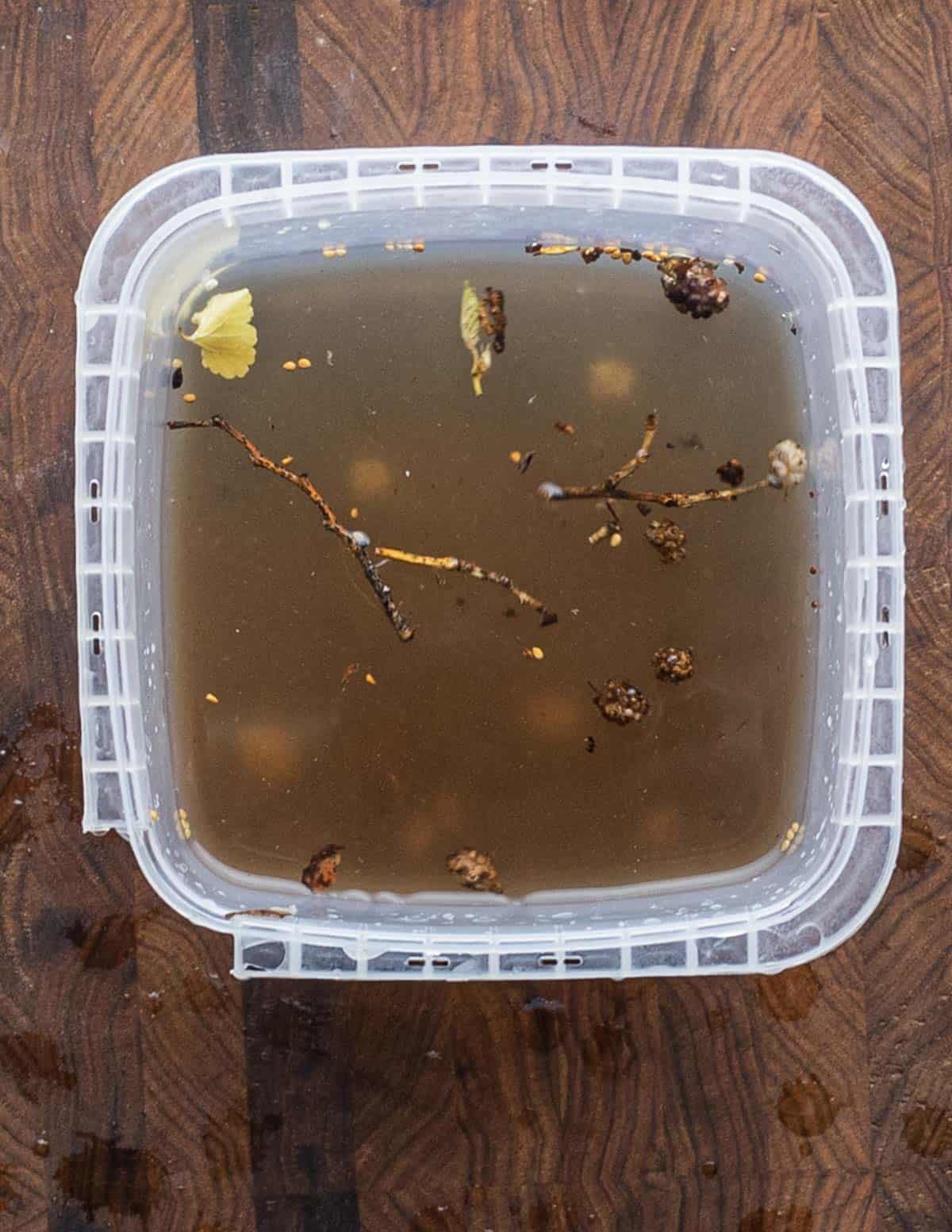
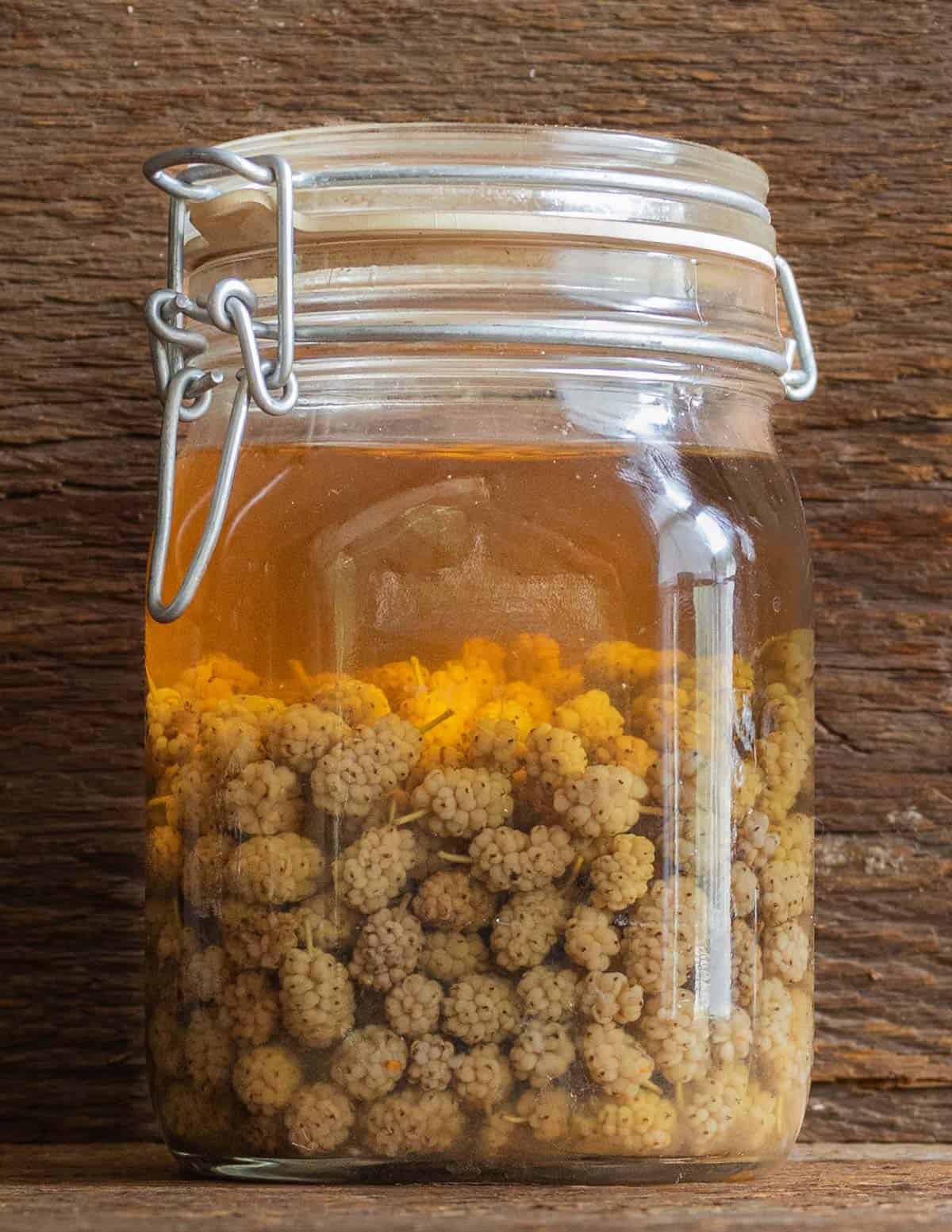
What to do With Mulberries
Cooking with mulberries is just like blueberries or other juicy, ripe fruit. Jams, jellies and preserves are great. Pie is probably my favorite way to use them.

One question I get regularly is if the stems from fresh mulberries need to be removed before cooking. For the record, the stems are left on the fruit for cooking, and I have never seen a traditional recipe where they're removed. The stems soften after cooking and no one will notice them.
As they can be harvested in such large quantities, people around the world have developed ingenious recipes that can be used for dirty fruit or the juice.
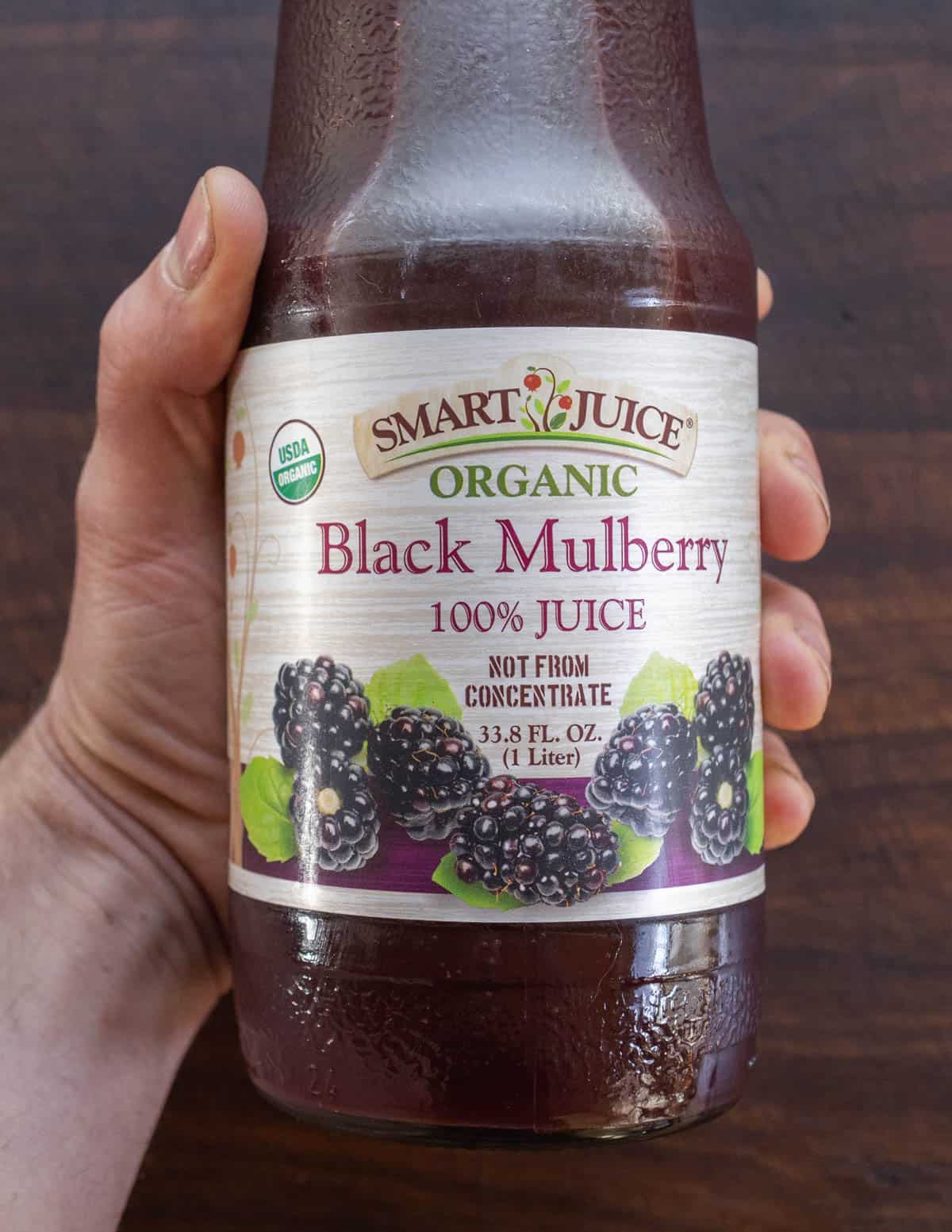
Besides mulberry wine, there's Turkey's pekmez or petimezi, a sort of fruit molasses made by cooking large quantities of fruit to extract a juice.
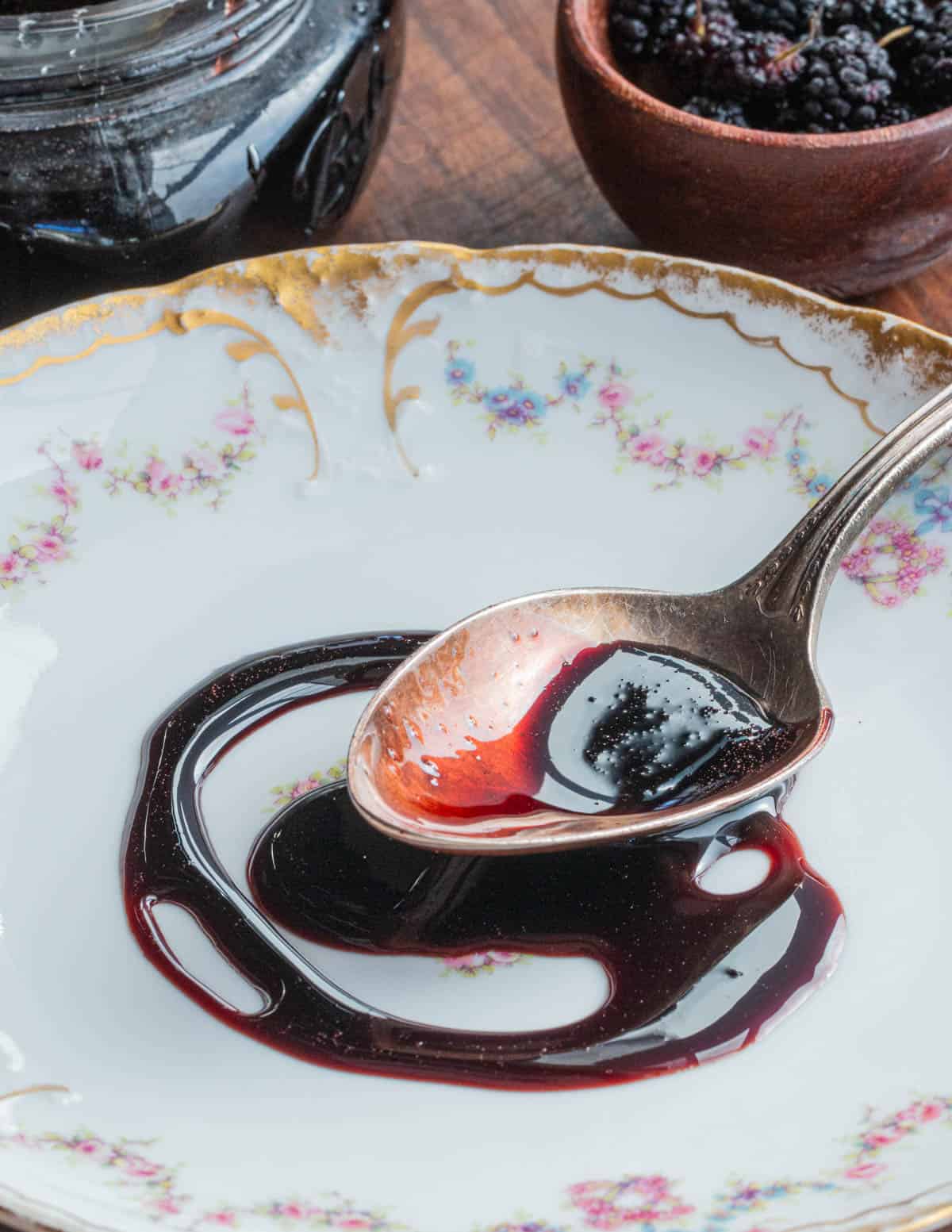
The juice is simmered until the natural sugar thickens to a molasses-like syrup. It's delicious, like a sweet pomegranate molasses without tartness. I like it with yogurt, fruit, nuts and wild rice for breakfast.
Jam is delicious too, and can be a good use for fruit lacking in taste, making it a good recipe for white mulberries. The tender seeds make it taste reminiscent of fig jam.
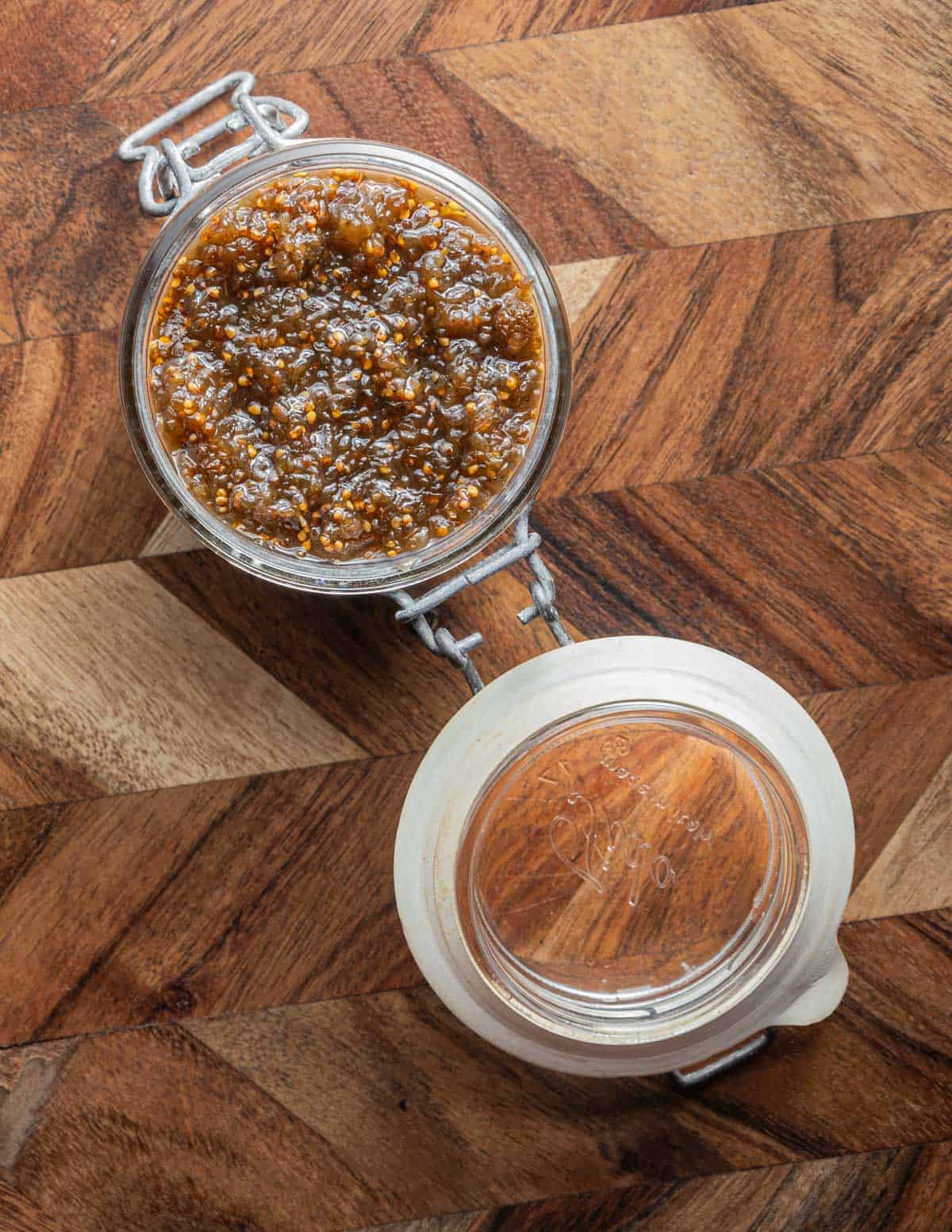
Eating Mulberry Leaves
If the fruit wasn't interesting enough, mulberry leaves are edible too. Young leaves harvested when the stems are still green (see the picture below) can be used fresh, dried or added to soups. Sometimes the leaves are taken for supposed health benefits, but I just like the flavor.
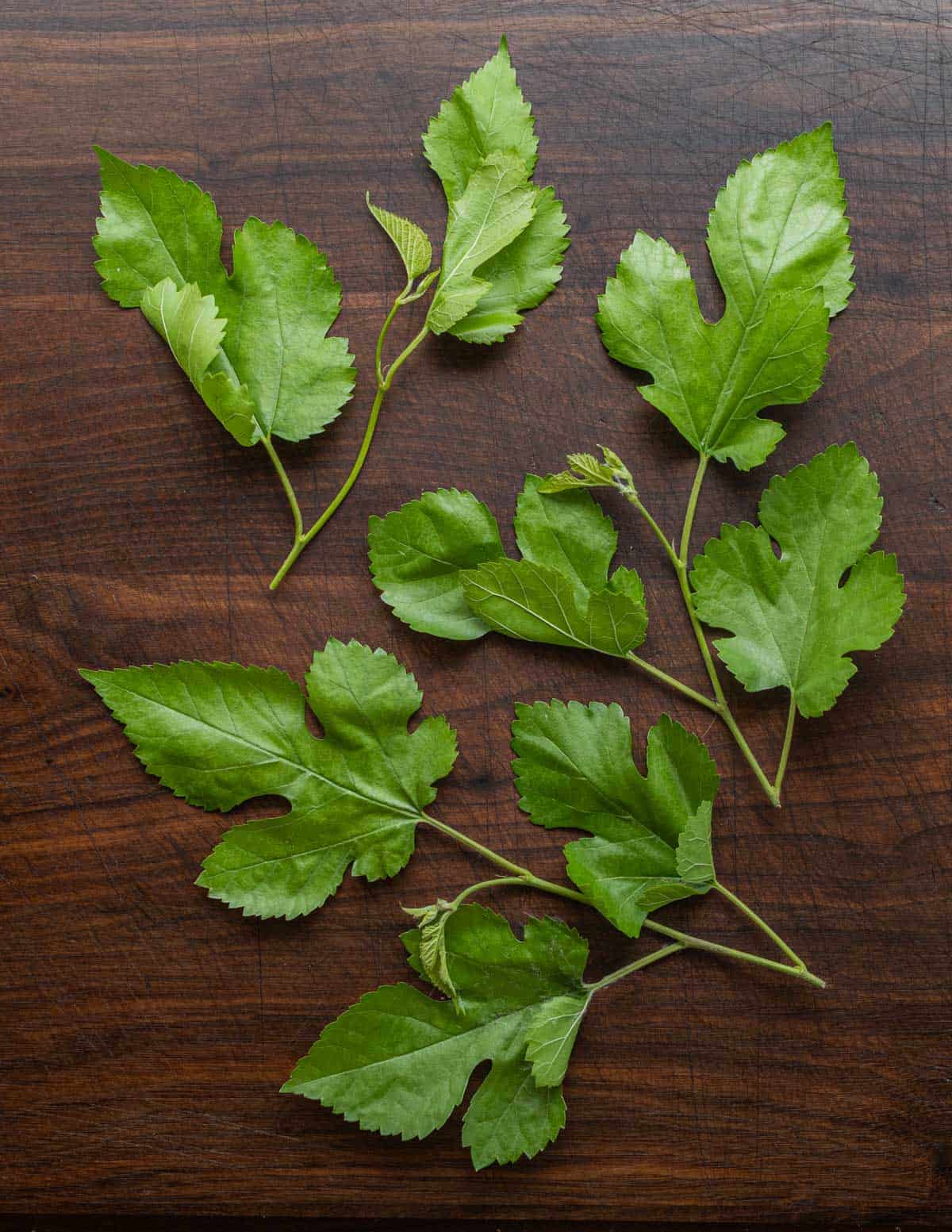
A friend of mine likes to mix dried mulberry and persimmon leaves together for a mellow blend. The image below shows the dried leaves in a tea ball above a mug of fresh white mulberry leaf tea.
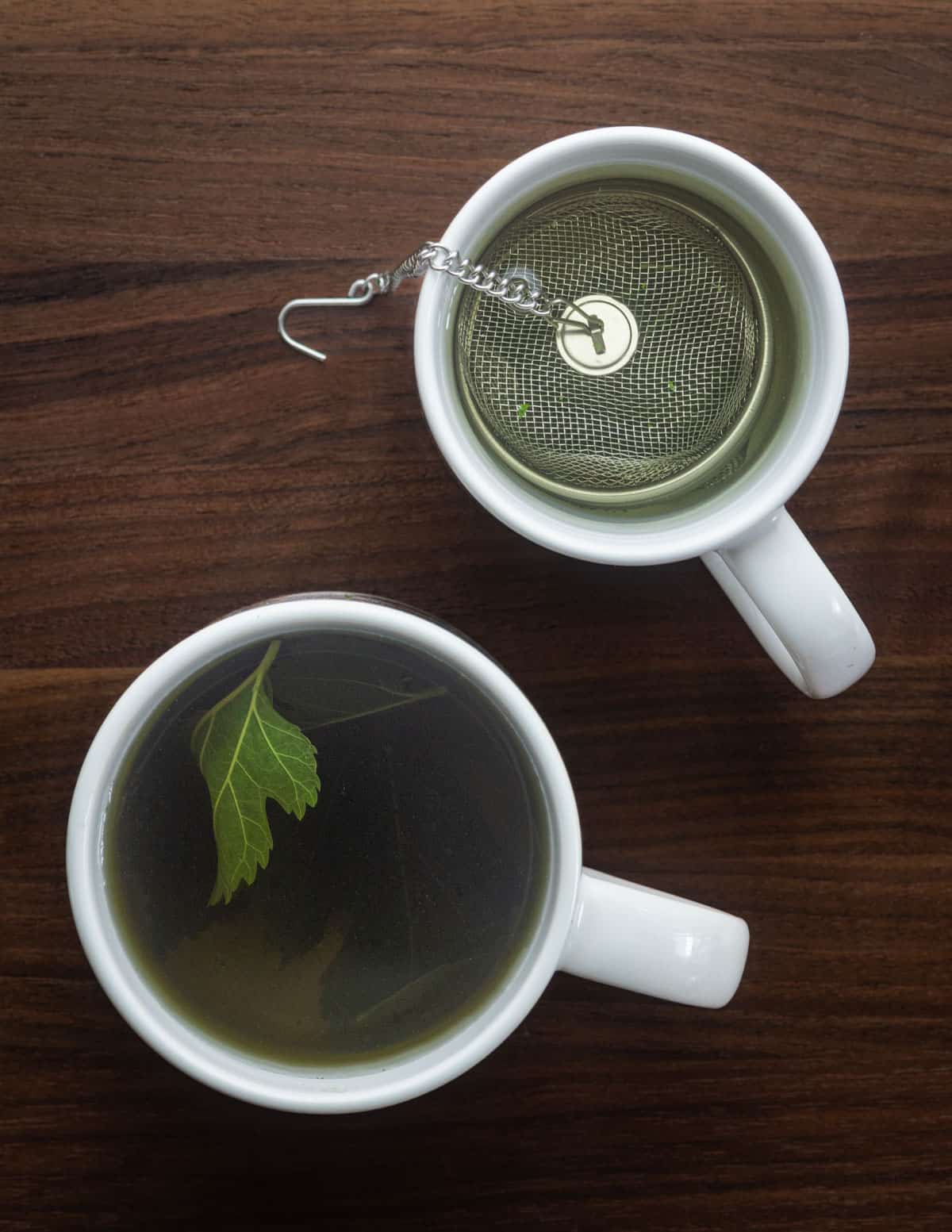
Harvesting young leaves to cook as a soup vegetable is a novel way to use young weedy saplings. Think less spinach, and more how you would use parsley.
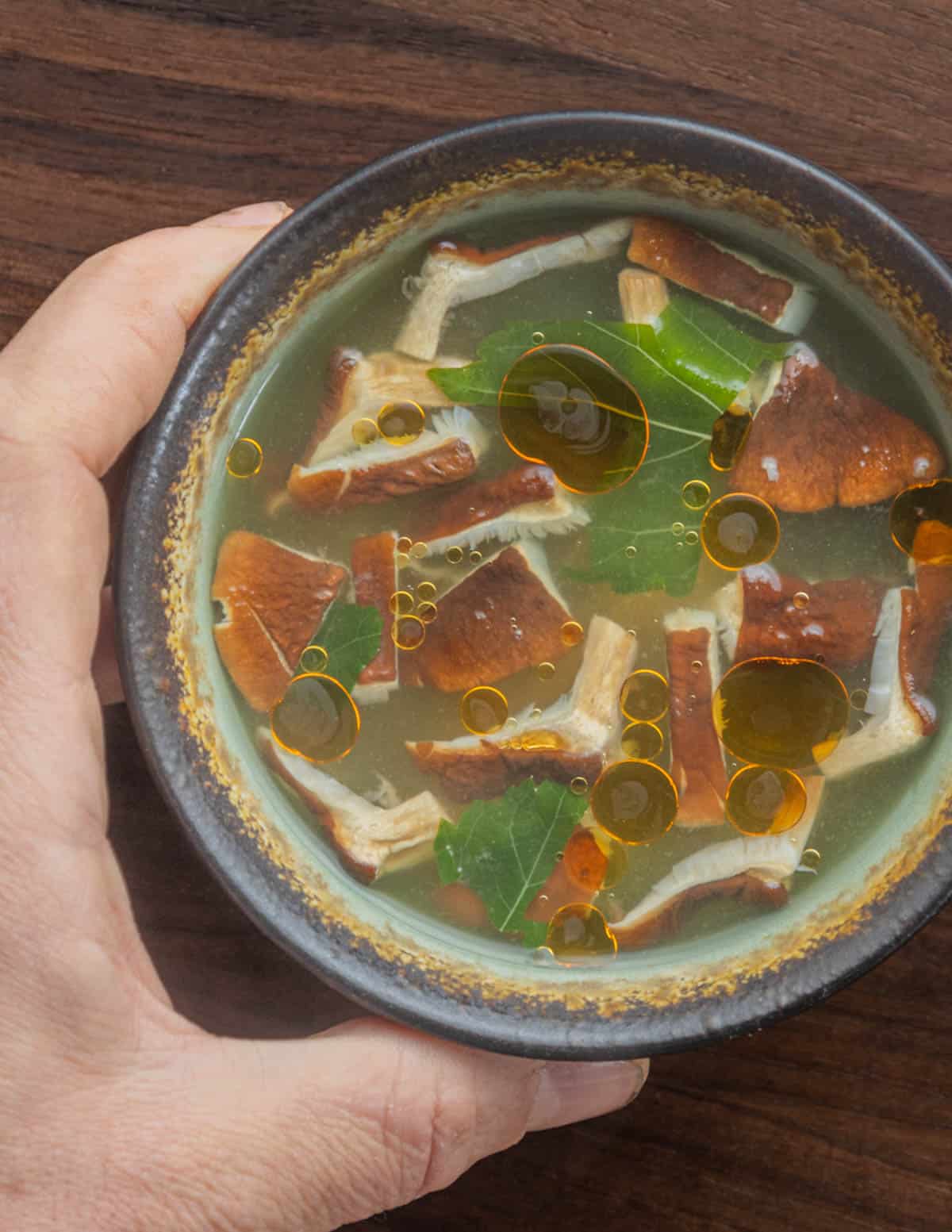
Young leaves have a mild, vegetal flavor and can be simmered until tender in soups and stews, about 4-5 minutes. Older leaves can be fed to chickens and rabbits.
How to Preserve and Store Mulberries
After the harvest you'll need to work fast to clean, process and preserve the fruit. If they're chilled quickly and stored in a refrigerator you'll have a few days to cook and process the fruit.
How to Freeze Mulberries
Like many berries, freezing is the easiest way to preserve the fresh fruit. Once they're frozen they can be cooked as if they were fresh anytime you need.
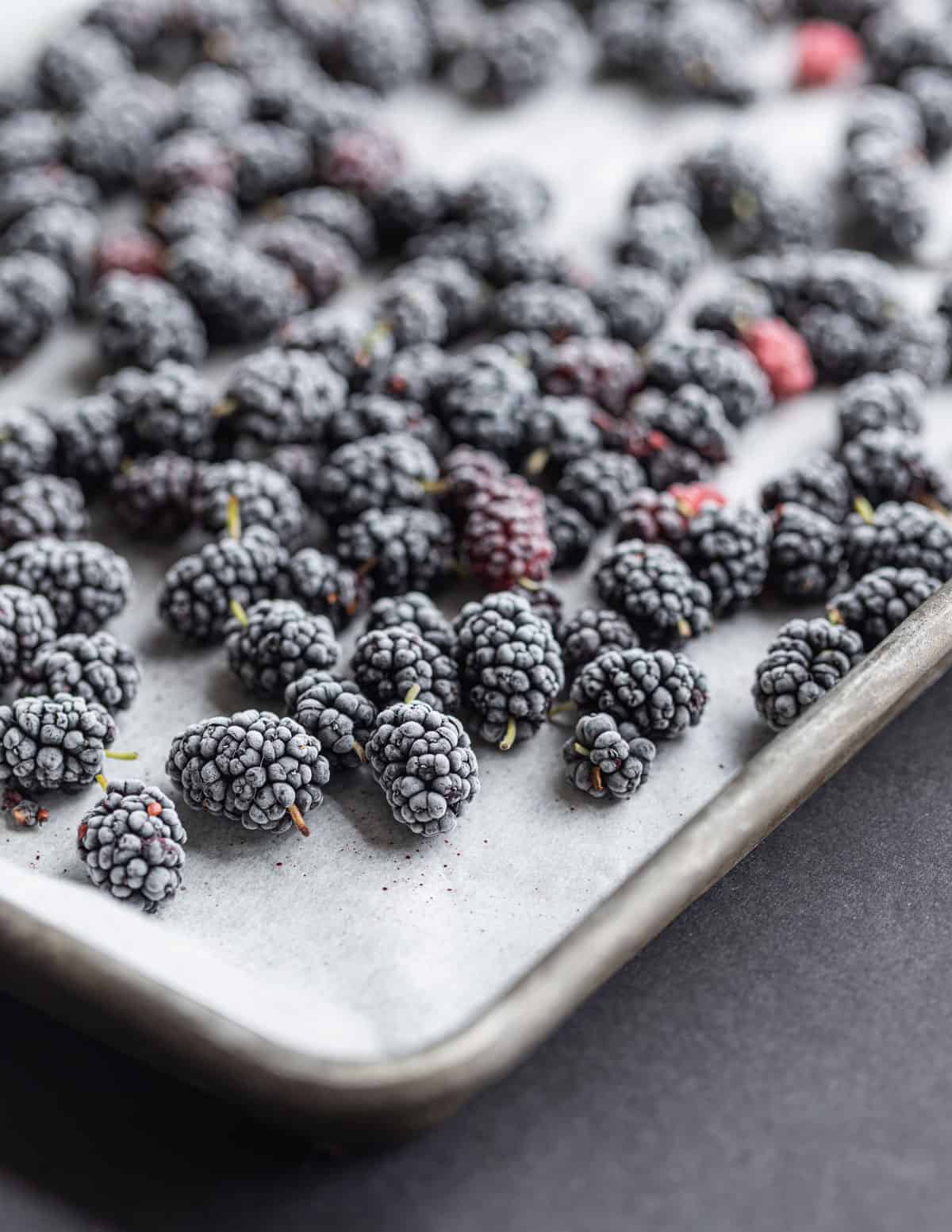
To freeze mulberries, lay the fruit on a sheet of parchment on a baking tray and freeze solid, then transfer the fruit to a bag or container in the freezer. The frozen fruit can be added directly to recipes, especially mulberry muffins and cake batters.
How to Dehydrate Mulberries
I occasionally see the dried fruit sold coops and some specialty grocery stores. They can be added to smoothies, ground powder for use in baked goods, or rehydrated. I've simmered dried fruit in mulberry juice to improve their flavor when I run out of frozen ones.
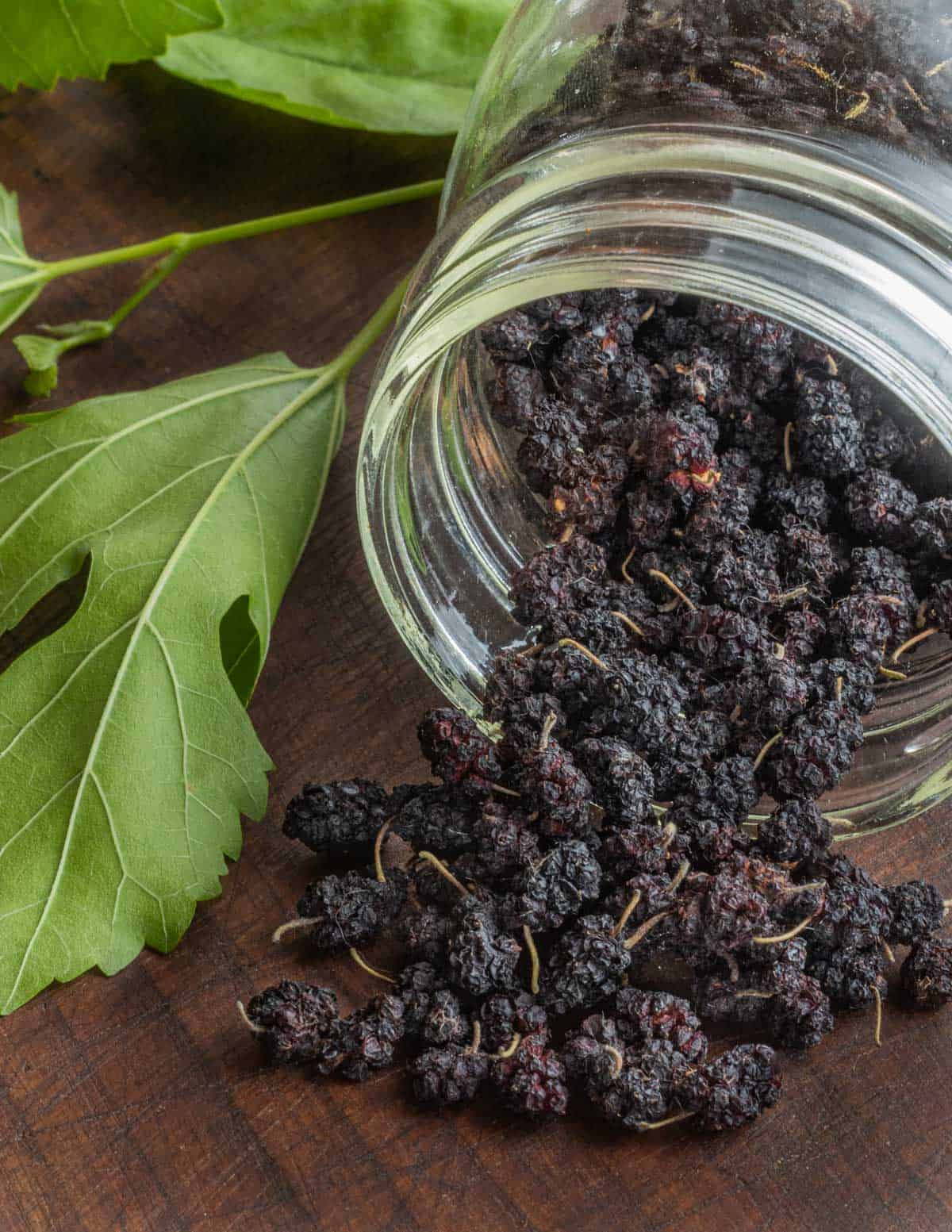
To dry the fruit, put the fruit in a dehydrator and dry on the fruit setting (high, around 145 F) until cracker dry, about 24 hours, then store in a jar in a pantry.

Lorenzo
Such an incredibly helpful post. Thank you chef
Darryl Trimble
I live on the Snake river, Idaho. Mulberries are prolific along the river corridor. Ive adopted a few groves and care for them. In Israel, they are called, "the Tree of Life" as spoken of in the book of Genesis.
I love eating them. Seems like no one else here does.
Mulberries make great pies, sauces and toppings for icecream, pancakes, waffles, on smoked salmon, etc.!
Alan Bergo
Thanks Darryl
Mike Moranz
Alan,
Just made your pie and it is just right. Yes, hints of figs and blueberries make for a very tasty and not too sweet desert. I did deviate slightly from the recipe in that I only made it with half of the berry mix making it more crust focused. Reminds me of Fig Newtons in a way with the less juicy and slightly seedy filling.
I picked around Bloomington from half a dozen trees with drooping branches around commercial parking lots, ponds, trails, and parks. Many of the trees still have all green berries while 50 feet away they are 50% ripe. Holding a bucket up to the limbs and using your fingers they roll off and most of them are caught. With 2 people, one holds the branch and the other picks. I think we can expect another week or more of picking. Thanks again for your recipe.
Alan Bergo
Hey Mike glad you liked it. And thanks for the headsup! One person told me they picked a few berries yesterday, I figure this heat and rain is going to make them go quick so I better check on my trees.
Tim
The Mulberry Bush song didn't start life as a children's rhyme. Its actually a satire on the English nobility who were wanting to start up a silk industry in England but were failing to get the necessary mulberry trees to survive. So, they'd try every trick they could think of to get mulberry trees to survive. When the nobles would get to talking about new ideas try to get mulberry trees to survive, their laborers would say to themselves "here we go round the mulberry bush, the mulberry bush, the mulberry bush." Can you just see them rolling their eyes? That's also why the lines of the song are about how to do this or that peculiar weird thing "so early in the morning" because the nobles would have the laborers do peculiar weird and seemingly unrelated things to get the mulberry trees to survive like "this is the way we wash our hands, wash our hands, wash our hands. This is the way we wash our hands so early in the morning!" After all these hundreds of years, you can still hear the exasperation of the laborers in those lines. Its no mistake that they were calling it a bush. The laborers were being a bit derogatory. Hilarious isn't it?
Alan Bergo
Thanks for sharing Tim.
Lois Handel
Oh man, this is well timed! My daughter & I discovered Mulberry trees while riding in IA at a state park several years ago, all our friends thought we were crazy eating something we didn't really know! But after one taste, I knew it was good! We filled our saddlebags and brought some back to camp, and really enjoyed! In fact I liked them so much, I found some on the web and bought a tree! It's in it's 2nd or 3rd year now, and growing really well, I'll have berries this year! I stuck it next to an Elderberry bush, probably way too close and they are too close to the sewer too, oops. but as they produce shoots, I'll move those! Whatever was I thinking when we put them in that location? (it's in a shady, wetter area of my yard, that's what!). And they both love the spot!
Thanks for the tips on harvesting and cooking them! Love your book, I don't get out to forage much these days, but the garden and backyard still produce enough to not mind!
Alan Bergo
Hey Lois, nice to hear from you.
Kristine
Researchers from North Dakota State University created clones of a 130+ yr old mulberry tree from Valley City, ND (Trader Mulberry-morus nigra). I planted two trees last year and they started budding a few weeks ago. No one has mulberry trees where I live in Northern MN so I am really looking forward to sharing the fruit!
https://www.jamestownsun.com/news/vc-native-creates-clone-of-white-mulberry-tree
Alan Bergo
Well that's really interesting. Thanks for sharing Kristine.
Pete
Never ate enough cooked to notice. Maybe it was just all the fiber in the raw berries.
Alan Bergo
Thanks. Good to note either way.
Sam Schaperow
I'll be sharing this great article. About dried mulberries, I bought some from a discount retail store that I think we're made in the middle east, and they were really delicious! I wonder why they were so good. I will try drying some good quality ones when I get a hold of them in enough quantity in the future and see how they compare. They might have been White mulberries.
Alan Bergo
Hey Sam. Yeah I think there’s a lot we don’t know about why the flavor differs so much between trees. Sun, soil, species-seems to be lots of variables.
Mike Moranz
Alan,
Good article for an underrated fruit. I think the taste is like ripe grapes, not much acidity, very sweet and a little woodsy when ripe. Don't like the white ones. Even the drops that should be ripe are pretty bland.
Ate the dark ones by the handfuls in my younger days dirt biking in IL. They are considered excellent farm field windbreaks. On a hot summer day we took breaks in their shade and gorged. Don't know about narcotic effect but afterwards our bikes seemed to go faster.
As an assessor in St Paul I found them in the Daytons Bluff and Mounds Park neighborhoods. Drive or walk down the street and look for purple stains on sidewalks. some trees are so low you can pick from public sidewalk. I use a berry bag or bucket around my neck so I can use two hands on a ladder. Will try your pie this year.
Alan Bergo
The pie is probably my favorite of all the berries-lots of emails about it lately. Definitely agree the white ones can be really bland, but even the bland ones will taste a little like figs after they're made into jam. I have found some white ones that are good-it's just hard to find the right tree at the right time.
Pete
I grew up in North Mankato with a 5-trunked monster mulberry in our backyard (although only 3 of the trunks actually produced fruit).
It was one of the focal points for all the kids in our neighborhood. We built 3 platforms among the branches and a couple of ladders for easier access. When the tree was fruiting it was not unusual to see as many as a dozen kids climbing around, filling our faces with fresh berries. Our eating was almost exclusively fresh, although my mom would occasionally try her hand at pie.
The days in our mulberry are among the most vivid and best childhood memories I have. One precautionary note, though. A large quantity of mulberries can be a powerful laxative. Eater beware.
Alan Bergo
Thanks for sharing Peter. Have you experienced the laxative effect with cooked fruit, raw, or both?
JoAnne
What a great article on a fruit that my children love. Hopefully I can find a tree to plant in zone 7B
Alan Bergo
Thanks JoAnne. Took me about 3 years to get the images, cooking, editing. Such a good fruit.
Brigitte Matiatos
That soup looks awesome! It's great to know that the leaves can be used in those amounts and appear to be quite versatile. I recall that they were a few black mulberry trees between Laurel and Holly/Portland going west from Western (grew up around Selby+Western). I haven't been back walking through that area in a couple years since I moved north of the cities, but I haven't seen much around Lindstrom. At least there are plenty of serviceberries and wild blueberries that I usually get from Banning State Park later this summer. Now I'm craving mulberries though. The hunt begins! Thanks!
Alan Bergo
Thanks Brigitte. I used to live on Selby and Western so I know right where that is. I’ll have to check on them. My best trees were removed from Oak Savannah restoration, nice to see the oaks get their due though.
Brigitte Matiatos
Yes! Might as well check it out next time you're in the area. Not a bad spot to live, but I got priced out of there rent-wise when I was living on Dayton as an adult as a produce buyer at Mississippi Market. Anyways, I do remember that they had dried mulberries at the co-op, but it really was not the same, in my personal opinion. Looking forward to scouting them out soon and doing something with them aside from eating them fresh (though extremely tempting)! Not a lot of oaks in my neighborhood either. Surprised I have to look for them, but I look forward to making acorn flour this year if things line up. Thanks for getting back, and good luck!